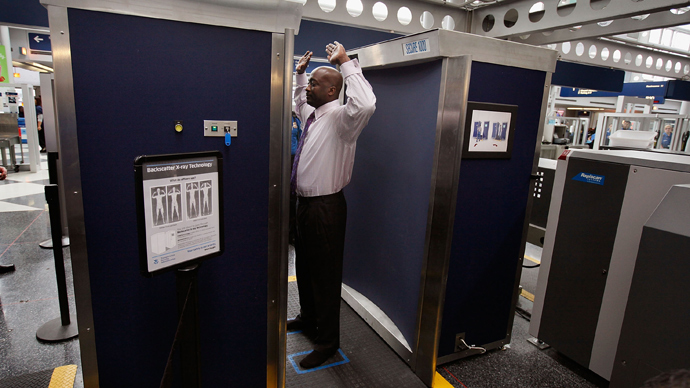'Useless' TSA scanners provided endless fodder for employees, former agent alleges

The Transportation Security Agency was aware that, before they were even introduced, the full-body scanners used at airport security checkpoints were flawed, according to a former TSA agent who alleges employees regularly peered and laughed at travelers.
Jason Edward Harrington, who spent years for the TSA as he studied for a creative writing degree, wrote a long piece in Politico detailing the ineptitude and casual jokes that often came at the expense of the agency's own inability to prevent an airplane hijacking.
The TSA decided to begin using full-body scanners in 2010, after an Al-Qaeda extremist tried to ignite a bomb in his underwear on a Christmas Day 2009 flight from Amsterdam to Detroit. The reaction was overwhelming and immediate, with civil liberties advocates asserting that a potential traveler would unnecessarily expose themselves to TSA agents, and that the radiation from the machines was dangerous.
Despite controversy, the agency pressed on an eventually doled out between $130,000 and $170,000 for each of the hundreds of machines in an effort to ramp up security at airports across the country.
“We knew the full-body scanners didn't work before they were even installed,” Harrington wrote in the article published Thursday. He went on to describe how a trainer described the machines as “shit” and said that they could be subverted if a would-be hijacker simply wore metal on the side of their body.
“We quickly found out the trainer was not kidding,” he continued. “Officers discovered that the machines were good at detecting just about everything besides cleverly hidden explosives and guns. The only thing more absurd how how poorly the full-body scanners performed was the incredible amount of time the machines wasted for everyone.”
The problem evidently went uncorrected even after the public caught on. A blogger named Jonathan Corbett attracted millions of views to his YouTube page by proving its possible to simply place a gun sideways on one's leg to bring it through security undetected.
“Finally, the public had a hint of what my colleagues and I already knew,” he wrote. “The scanners were useless. The TSA was compelling toddlers, pregnant women, cancer survivors – everyone – to stand inside radiation machines that didn't work...behind closed doors, supervisors instructed us to begin patting down the sides of every fifth passenger as a clumsy workaround to the scanners' embarrassing vulnerability.”
Harrington is not the only TSA employee to complain about his time with the agency, with employee happiness ranked at or near the bottom of all government agencies polled in annual job satisfaction surveys. The full-body scanners made the day more cumbersome, Harrington noted, while the Image Operator (IO) room quickly turning into a place where bored employees could find a laugh.
“Just as the long-suffering American public waiting on those security lines suspected, jokes about the passengers ran rampant among my colleagues: Many of the images we gawked at were of overweight people, their every fold and dimple on full awful display,” he wrote.
“Piercings of every kind were visible...One of us in the IO room would occasionally identify a passenger as female, only to have the officers out on the checkpoint floor radio back that it was actually a man. All the old, crass stereotypes about race and genitalia size thrived on our secure government radio channels.”














